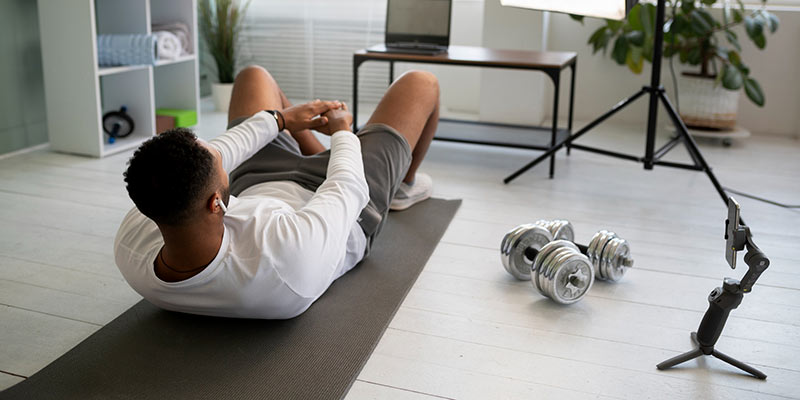You don’t need a massive budget or a spare warehouse to build a home gym. With some planning, smart purchases, and creative use of space, you can create a workout area that helps you stay consistent without draining your bank account.
Why Create a Home Gym?
A home gym offers the ultimate convenience. You can work out whenever it suits you, skip the commute to a fitness center and avoid waiting for equipment.
It can also save you money in the long run. Instead of paying monthly membership fees, you can gradually invest in equipment you’ll use for years. Plus, you have complete control over the space — from music to temperature — making it easier to stick to your routine.
According to a 2023 survey, over half of the participants prefer home-based workouts over a neighborhood gym. Having all the fitness equipment you prefer at home means it’s available whenever you feel like a workout, and you don’t have to fight sweaty gym goers for your favorite dumbbell.
Initial Setup Steps
Before buying anything, take the time to plan your space and priorities. A thoughtful setup will make your gym more comfortable, safer, and easier to use from day one. Planning also means you won’t waste money on equipment you rarely use or have no space for.
Analyze Your Space
Decide where your gym will be and measure the available area. Even a small corner can work if you plan carefully.
Decide on Your Gym Needs
Think about your regular workouts. Prioritize equipment that matches your training style so you don’t waste money on unused gear. Treadmills, exercise bikes, and weight equipment remain popular and versatile home-based gym choices.
Pick Your Flooring
Install rubber mats or foam tiles to protect floors and reduce noise. Choose a thickness that supports your equipment and reduces the risk of slipping and injuries. With a pour-in rubber flooring made from recycled rubber, you reduce your carbon footprint while creating a hygienic, functional space.
Install a Mirror
A mirror helps you monitor your movements for correct form, whereas exercise apps without correct feedback can negatively influence movement accuracy. A mirror makes a small space feel larger, but mount it securely to avoid accidents.
Make It a Functional Gym
Once your space is ready, focus on equipment that maximizes workouts without crowding the room. Start with multipurpose pieces that you get maximum use from.
Choose an Adjustable Bench
A bench expands your exercise options, from presses to step-ups. For versatility, pick one with multiple incline settings.
Select Dumbbells, Kettlebells, and Weight Systems
Opt for adjustable sets to save space and money. For dumbbells, a starter range from 5 pounds to 25 pounds works for most beginners, while more advanced lifters may want up to 50-pound weights or more. Kettlebells from 10 pounds to 30 pounds cover a wide variety of movements.
Gradually add heavier weights as your strength improves. Adjustable dumbbells are handy, so consider their cost compared to individual weights.
Splurge on Resistance Bands
Elasticated bands are affordable, portable, and great for strength training, stretching, and rehab exercises.
Add Racks and Solid Mounts
Secure storage and mounts keep your space organized and equipment stable during use. When installing wall mounts, pull-up bars, or heavy racks, use anchors of at least four to six inches to ensure they’re anchored into weight-bearing wall studs or concrete and rated for the weight you’ll load on them. This prevents accidents and ensures long-term safety.
Your Gym Wishlist
After you’ve covered the basics, consider extras that can expand your training options. These aren’t essential now but are worth saving for.
Machines
If you want a treadmill, bike, or rower, shop secondhand or wait for seasonal sales to cut costs. Cardio machines can be a big investment, so start with the one you’ll use most often. A treadmill is ideal for walkers and runners, a stationary bike works well for low-impact workouts, a rowing machine delivers a full-body cardio session in a small footprint, and indoor rowing has gained 20% popularity since 2014. Whichever you choose, look for a sturdy frame, adjustable resistance, and easy storage options.
Jump Boxes
Sturdy plyo boxes or step platforms add cardio and strength variety without taking up much space.
Allocated Storage
Shelves, bins, and wall hooks keep weights, mats, and accessories tidy and accessible. Jump boxes can double as storage bins, while regular peg boards can organize towels, weight bands, and resistance cords.
Raise the Bar on a Home Gym
Building a home gym is about wise choices, not expensive purchases. Start with versatile equipment, expand as your fitness grows, and adapt the space to your needs. Over time, you’ll create a setup that keeps you motivated, comfortable, and committed to your health goals without ever leaving home.

